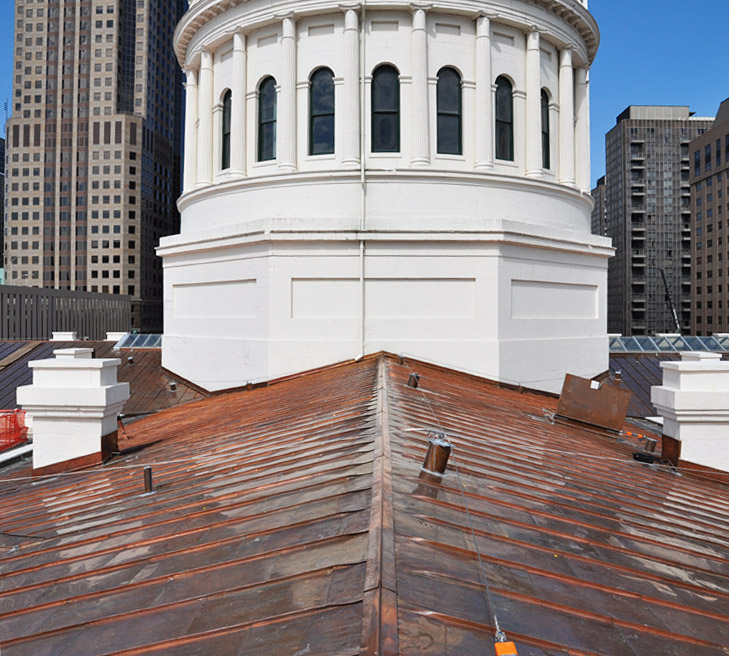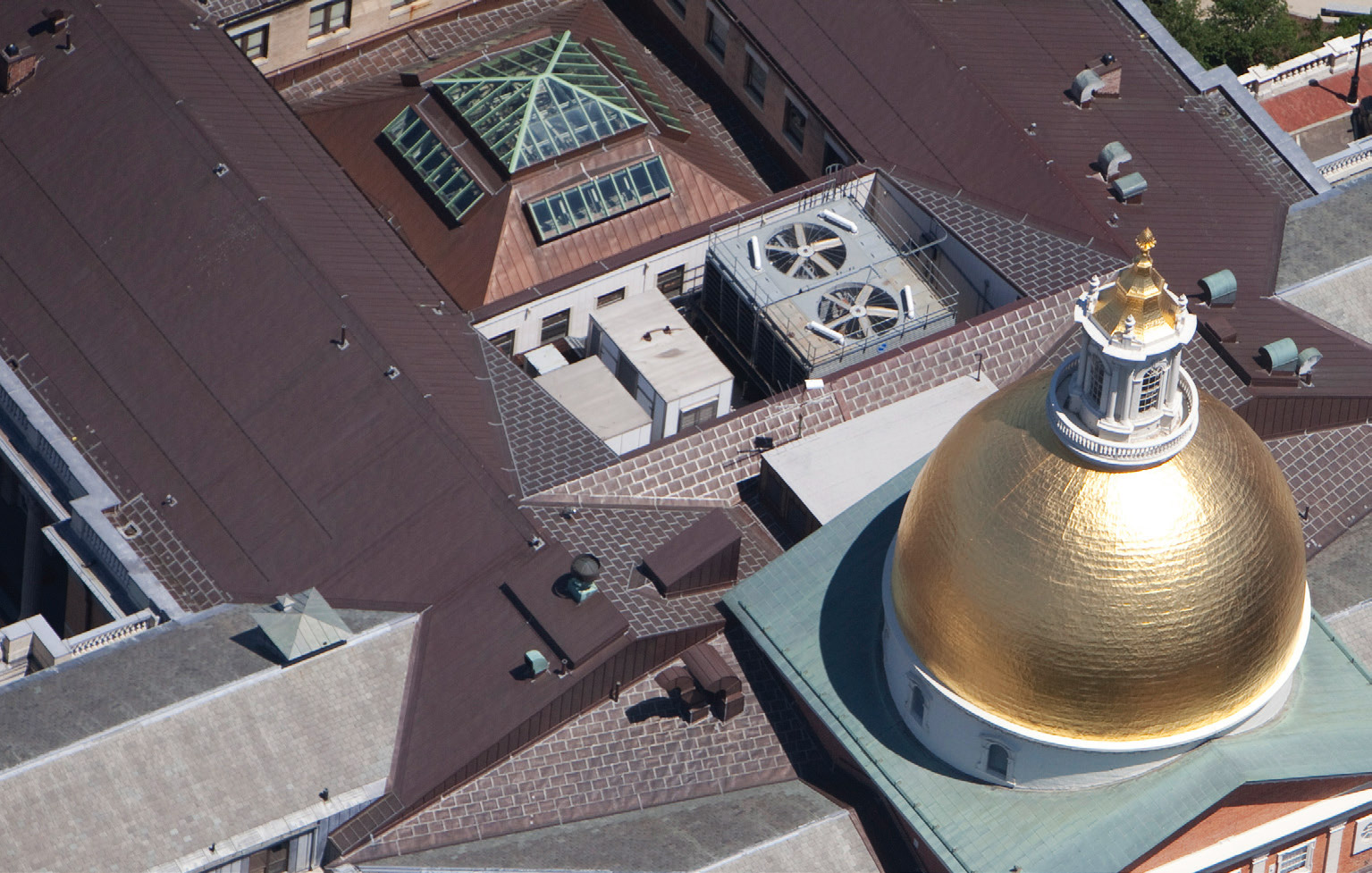North American Historic Landmarks Rely on Copper

The Old Courthouse in St. Louis, MO
Photo Credit: Quinn Evans, Architects: Ann K Dilcher
Each year, the Copper Development Association awards a handful of new and recently restored buildings in the U.S. and Canada that utilize architectural copper and copper alloys in their design. Award recipients include a variety of government buildings, academic facilities, houses of worship, upscale residences and many more—most of which are now considered historic landmarks. But why is it that we see so many landmarks using copper?
Known as mankind’s oldest metal, copper delivers an unparalleled beauty while providing durability, longevity and malleability, making it a preferred building construction material, time and time again. For centuries, copper elements have contributed to a project’s architectural significance and have been prominently showcased in the landscape of building design.
“Copper’s natural patina has a very attractive appearance as it ages, and also when it has aged,” said Nick Lardas, owner of Niko Contracting, located in Pittsburgh, PA. “What makes it most attractive though, is that it’s a life-long material—a copper roof can last for more than 100 years if it’s built right.”
While copper adds a sense of grandeur to any building, it is also widely known for its durability.
Outdoors, copper and its alloys like brasses and bronzes can withstand harsh exposure to the elements and wear from constant use better than any other material. It will not rust, yet, gradually, copper attains an attractive, stable patina that enhances the appearance of statues, roofs and other decorative and architectural applications.
CDA recently honored the Old Courthouse in St. Louis, MO with a North American Copper in Architecture Award (NACIA) for the restoration of its age-old copper roof. Constructed in 1828, the Old Courthouse is considered one of the country’s most prominent architectural landmarks, as it has been the site for several important legal cases, including the first two trials leading up to the Dred Scott decision. Originally, the courthouse roof was designed using a tin and timber roof structure; however, the National Park Service (NPS) replaced the original roof with copper when it took the building over as part of the Jefferson National Expansion Memorial in 1941. In order to preserve this important landmark, the NPS sought to design a replacement roof with the intention of staying true to the building's historic design. Because of its durability and longevity, copper was selected as the appropriate replacement material.
Longevity? Yes. While all structures experience wear-and-tear over time, architects and contractors can trust copper will not deteriorate or corrode with age. As a result, this metal is often used on buildings designed to last a lifetime, or longer.
“Copper has been chosen throughout history because it’s a very long-life product, and also because it’s one of the easier sheet metals to work with in terms of forming, joining and soldering,” said Lardas, who has worked with the metal for more than 40 years.

The Massachusetts State House Building
Photo Credit: The Commonwealth of Massachusetts Division of Capital Asset Management & Sky High Enterprises
In 2008, the Library of Parliament in Ottawa, Ontario underwent a major restoration on one of the most prominent features of its structure—its magnificent copper roof. First opened in 1877 after 18 years of construction, the main objective was to give the library an extended life span of 50 additional years. Since a properly designed and installed copper roof should last upwards of 100 years or more, the newly installed copper roof should still be performing as intended for years to come. Eventually, the roof will feature a beautiful natural patina, typically associated with buildings on Parliament Hill.
Copper is also often used because it is extremely malleable and formable—it can be formed, bent and stretched into complex and intricate surfaces without breaking. This makes it possible to easily create spires, steeples, domes, non-linear roofs and walls, as well as complicated dormers, fascia and the like.
In 2012, the Massachusetts State House—known as the ‘Hub of the Universe’ in the Massachusetts political system—completed a brand new roof restoration. Erected in Boston in 1795, the dome was originally covered by wood shingles and, later, gold leaf. However, in 1801, it became the first building in North America to ever apply cold-roller copper. The roof system on the State House is truly one-of-a-kind in design and functionality. Twenty and thirty-two ounce copper adorns the majority of the State House because of its workability, aesthetic appearance and historical significance to building itself. The design creates a fully functional masterpiece that protects the contents below and preserves the historic nature of this monument to American history.
“Throughout time, mankind has used copper to protect and adorn our most important, most prominent, most influential buildings—many of which in the U.S. are recognized as national historic landmarks,” said Andy Kireta Jr., vice president of CDA. “Ellis Island, the U.S. Capitol, New York’s Plaza Hotel, the Massachusetts State House, the Old Courthouse and many others—iconic buildings that played notable roles in the birth and growth of the United States, continue to look to copper for life-long protection and lasting beauty. Because of these same attributes we continue to see copper being used in new and innovative ways, from intricate wall-cladding systems to interior applications on buildings that are likely to be our historic landmarks of the future.”
For more information about copper in architecture, visit the Architecture Section.
Also in this Issue:
- North American Historic Landmarks Rely on Copper
- Copper Proves to Be the Superior Piping System for Hospital Expansion Project
- Copper Industry Advises Plumbing Professionals in Soldering New, No-Lead Copper Alloys
